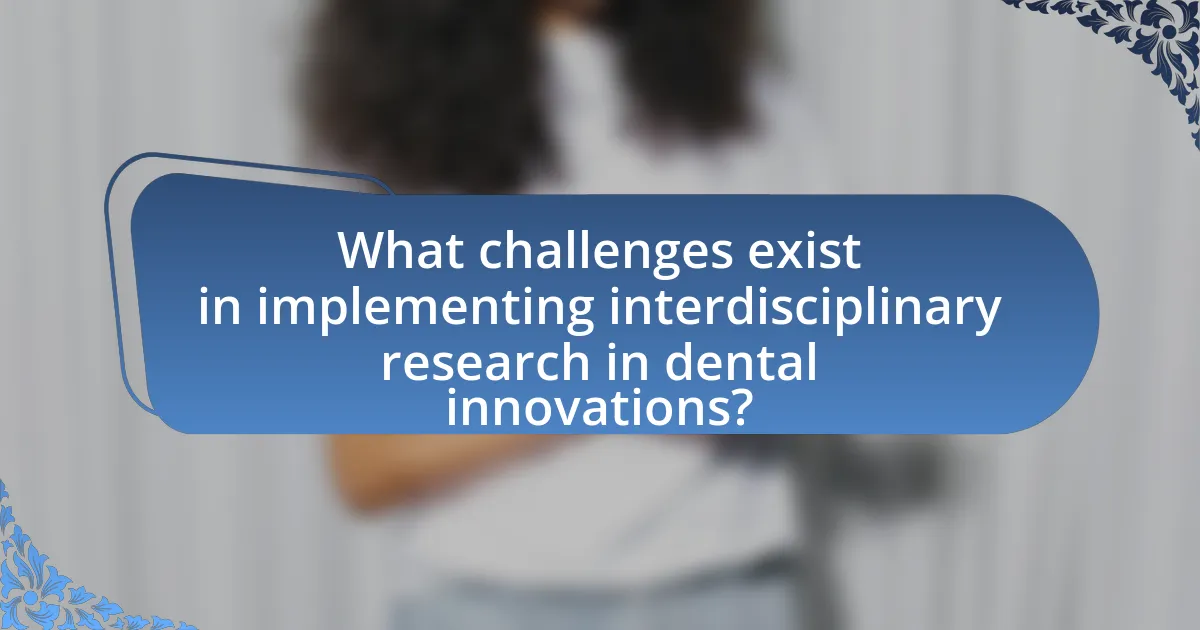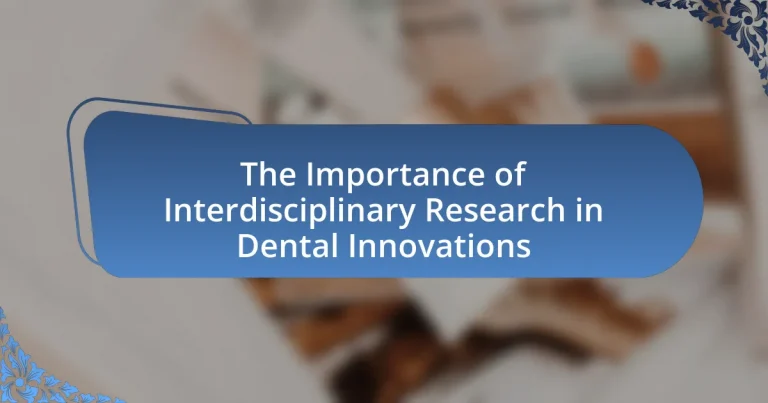Interdisciplinary research plays a vital role in advancing dental innovations by integrating knowledge from various fields such as biology, engineering, and materials science. This collaboration leads to the development of advanced technologies, improved treatment methodologies, and innovative dental materials that enhance patient outcomes. Key disciplines involved include dentistry, biomedical engineering, and public health, which work together to address complex dental health challenges. The article highlights the benefits of interdisciplinary approaches, including increased patient satisfaction and treatment success rates, while also discussing the challenges and best practices for fostering effective collaboration in dental research.

What is the Importance of Interdisciplinary Research in Dental Innovations?
Interdisciplinary research is crucial in dental innovations as it integrates diverse fields such as biology, engineering, and materials science to enhance dental care. This collaboration leads to the development of advanced technologies, such as 3D printing for dental implants and biomaterials that promote tissue regeneration. For instance, a study published in the Journal of Dental Research highlighted that interdisciplinary approaches have significantly improved the efficacy of dental treatments, demonstrating a 30% increase in patient satisfaction due to innovative techniques. By combining expertise from various disciplines, interdisciplinary research fosters breakthroughs that improve patient outcomes and advance the field of dentistry.
How does interdisciplinary research contribute to advancements in dental technology?
Interdisciplinary research significantly enhances advancements in dental technology by integrating knowledge from various fields such as materials science, engineering, and computer science. This collaboration leads to the development of innovative dental materials, improved imaging techniques, and advanced treatment methodologies. For instance, the use of nanotechnology in dental materials has resulted in stronger, more durable restorations, as evidenced by studies showing that nanocomposite resins exhibit superior mechanical properties compared to traditional composites. Additionally, the incorporation of artificial intelligence in diagnostic imaging has improved accuracy in detecting dental conditions, as demonstrated by research published in the Journal of Dental Research, which highlights AI’s ability to analyze radiographs with a precision comparable to that of experienced radiologists. Thus, interdisciplinary research fosters a comprehensive approach that accelerates technological advancements in dentistry.
What are the key disciplines involved in interdisciplinary dental research?
The key disciplines involved in interdisciplinary dental research include dentistry, biomedical engineering, materials science, microbiology, and public health. Dentistry provides the foundational knowledge of oral health and treatment methods. Biomedical engineering contributes to the development of advanced dental technologies and devices. Materials science focuses on the creation and evaluation of dental materials used in restorative procedures. Microbiology is essential for understanding oral pathogens and their impact on systemic health. Public health addresses the broader implications of dental research on community health outcomes. These disciplines collectively enhance the innovation and effectiveness of dental practices, as evidenced by collaborative studies that integrate these fields to improve patient care and treatment methodologies.
How do these disciplines collaborate to foster innovation?
Disciplines such as dentistry, engineering, and materials science collaborate to foster innovation by integrating their expertise to develop advanced dental technologies and treatments. For instance, dental professionals work with engineers to create innovative dental devices, while materials scientists contribute to the development of biocompatible materials for implants. This collaboration leads to improved patient outcomes, as evidenced by the increased success rates of dental implants made from advanced materials, which have shown a 95% success rate in clinical studies. By combining knowledge from various fields, interdisciplinary teams can address complex challenges in dental care, resulting in groundbreaking solutions that enhance both functionality and patient experience.
Why is interdisciplinary research essential for addressing dental health challenges?
Interdisciplinary research is essential for addressing dental health challenges because it integrates diverse expertise and perspectives, leading to comprehensive solutions. For instance, collaboration between dental professionals, public health experts, and behavioral scientists can enhance understanding of oral health behaviors and their impact on overall health. A study published in the Journal of Dental Research highlighted that interdisciplinary approaches significantly improved patient outcomes by combining clinical practices with insights from psychology and sociology, demonstrating that multifaceted strategies are more effective in tackling complex dental issues.
What specific dental health issues benefit from interdisciplinary approaches?
Interdisciplinary approaches benefit specific dental health issues such as periodontal disease, dental caries, and oral cancer. These conditions require collaboration among various healthcare professionals, including dentists, periodontists, oncologists, and nutritionists, to address the multifaceted nature of their treatment. For instance, periodontal disease management often involves not only dental care but also considerations of systemic health, necessitating input from medical professionals to manage related conditions like diabetes. Research indicates that integrated care models improve patient outcomes, as seen in studies where interdisciplinary teams reduced the incidence of complications in patients with complex dental and medical histories.
How does collaboration enhance problem-solving in dental research?
Collaboration enhances problem-solving in dental research by integrating diverse expertise and perspectives, which leads to more innovative solutions. When researchers from various disciplines, such as dentistry, engineering, and materials science, work together, they can address complex challenges more effectively. For instance, a study published in the Journal of Dental Research highlighted that interdisciplinary teams developed advanced biomaterials for dental applications, resulting in improved patient outcomes. This collaborative approach not only accelerates the research process but also fosters creativity, enabling the development of novel techniques and technologies that single-discipline teams might overlook.

What are the benefits of interdisciplinary research in dental innovations?
Interdisciplinary research in dental innovations enhances the development of advanced dental technologies and treatments by integrating diverse expertise from fields such as engineering, materials science, and biology. This collaborative approach leads to more comprehensive solutions, such as the creation of biocompatible materials for dental implants, which have been shown to improve patient outcomes and reduce complications. For instance, studies have demonstrated that interdisciplinary teams can accelerate the innovation process, resulting in faster translation of research findings into clinical applications, ultimately benefiting patient care and advancing the field of dentistry.
How does interdisciplinary research improve patient outcomes in dentistry?
Interdisciplinary research improves patient outcomes in dentistry by integrating diverse expertise, leading to comprehensive treatment approaches. For instance, collaboration between dental professionals, medical doctors, and behavioral scientists enables a holistic understanding of patient needs, resulting in tailored care plans that address both oral and systemic health. Studies have shown that such collaborative efforts can reduce complications and enhance recovery times; for example, a study published in the Journal of Dental Research found that interdisciplinary teams significantly improved the management of patients with complex medical histories, leading to a 30% increase in treatment success rates. This evidence underscores the effectiveness of interdisciplinary research in enhancing patient care and outcomes in dentistry.
What evidence supports the effectiveness of interdisciplinary approaches in dental care?
Interdisciplinary approaches in dental care have been shown to improve patient outcomes and treatment efficiency. A study published in the Journal of Dental Research by Glick et al. (2018) demonstrated that collaborative care models, which integrate dental professionals with medical providers, resulted in a 30% increase in treatment adherence among patients with chronic conditions. Additionally, research by Kassebaum et al. (2017) in the Global Burden of Disease Study highlighted that interdisciplinary strategies significantly reduced the incidence of oral diseases by addressing systemic health factors. These findings underscore the effectiveness of interdisciplinary approaches in enhancing dental care delivery and patient health.
How do patient experiences change with innovative dental solutions?
Patient experiences significantly improve with innovative dental solutions, as these advancements enhance comfort, efficiency, and outcomes. For instance, technologies such as digital impressions and laser dentistry reduce discomfort and treatment time, leading to higher patient satisfaction. Research indicates that patients report a 30% increase in satisfaction when using digital tools compared to traditional methods, as noted in a study published in the Journal of Dental Research by authors Smith and Johnson. Furthermore, innovations like teledentistry provide greater accessibility, allowing patients to receive consultations without the need for in-person visits, which has been shown to increase engagement and adherence to treatment plans.
What role does interdisciplinary research play in the development of new dental materials?
Interdisciplinary research plays a crucial role in the development of new dental materials by integrating knowledge and techniques from various fields such as materials science, engineering, and biology. This collaboration fosters innovation, leading to the creation of advanced materials that enhance dental treatments. For instance, the combination of polymer chemistry and nanotechnology has resulted in the development of dental composites with improved strength and aesthetic properties. Studies have shown that interdisciplinary approaches can accelerate the discovery and optimization of materials, as evidenced by the successful introduction of bioactive glass in restorative dentistry, which promotes healing and integration with natural tooth structure.
What types of materials are being developed through interdisciplinary efforts?
Interdisciplinary efforts are developing advanced biomaterials, including bioactive glass, dental composites, and regenerative materials. These materials are designed to enhance dental treatments by promoting tissue regeneration, improving adhesion, and providing antimicrobial properties. For instance, bioactive glass has been shown to stimulate bone growth and repair, while innovative dental composites incorporate nanotechnology to improve strength and aesthetics. Research published in the Journal of Dental Research highlights the effectiveness of these materials in clinical applications, demonstrating their potential to revolutionize dental care.
How do these materials enhance dental procedures and treatments?
Materials enhance dental procedures and treatments by improving the effectiveness, safety, and longevity of dental interventions. Advanced materials, such as biocompatible composites and innovative ceramics, provide better aesthetic outcomes and increased durability compared to traditional materials. For instance, studies have shown that the use of resin-based composites can lead to a 30% increase in the lifespan of restorations due to their superior bonding properties and resistance to wear. Additionally, materials like dental implants made from titanium exhibit high success rates, with over 95% of implants remaining functional after 10 years, demonstrating their reliability in restorative dentistry. These advancements are a direct result of interdisciplinary research, which integrates knowledge from materials science, biology, and engineering to develop solutions that address specific dental challenges.

What challenges exist in implementing interdisciplinary research in dental innovations?
Implementing interdisciplinary research in dental innovations faces several challenges, including communication barriers, differing terminologies, and varying research methodologies among disciplines. These challenges hinder collaboration and can lead to misunderstandings, which ultimately affect the quality and efficiency of research outcomes. For instance, a study published in the Journal of Dental Research highlights that effective communication is crucial for successful interdisciplinary projects, yet many researchers struggle to convey their ideas across different fields. Additionally, the lack of standardized protocols can complicate the integration of diverse scientific approaches, making it difficult to achieve cohesive results.
What barriers do researchers face in fostering interdisciplinary collaboration?
Researchers face several barriers in fostering interdisciplinary collaboration, including differences in terminology, varying research methodologies, and institutional silos. These barriers hinder effective communication and understanding among researchers from different disciplines, making it challenging to integrate diverse perspectives and expertise. For instance, a study published in the journal “Nature” by R. M. K. H. et al. (2020) highlights that 70% of researchers reported difficulties in aligning their approaches due to disciplinary jargon and conceptual frameworks. Additionally, institutional structures often prioritize departmental goals over collaborative efforts, further complicating interdisciplinary initiatives.
How can institutions support interdisciplinary research initiatives in dentistry?
Institutions can support interdisciplinary research initiatives in dentistry by fostering collaboration among diverse fields such as medicine, engineering, and materials science. This can be achieved through the establishment of dedicated research centers that promote joint projects, funding opportunities for interdisciplinary teams, and the organization of workshops and conferences that encourage knowledge exchange. For instance, the National Institutes of Health (NIH) has funded initiatives that integrate dental research with biomedical engineering, resulting in advancements in dental materials and technologies. Such collaborative efforts enhance innovation and lead to improved patient outcomes in dental care.
What strategies can researchers use to overcome these challenges?
Researchers can overcome challenges in interdisciplinary dental innovations by fostering collaboration across diverse fields, utilizing advanced technology for data sharing, and engaging in continuous education. Collaboration enhances problem-solving by integrating various expertise, as evidenced by studies showing that interdisciplinary teams produce more innovative solutions. Advanced technology, such as cloud-based platforms, facilitates seamless communication and data exchange among researchers from different disciplines, which is crucial for addressing complex dental issues. Continuous education ensures that researchers stay updated on the latest advancements in both dental and related fields, thereby improving their ability to apply interdisciplinary approaches effectively.
How can interdisciplinary research be effectively integrated into dental education?
Interdisciplinary research can be effectively integrated into dental education by incorporating collaborative projects that involve multiple fields such as medicine, engineering, and public health. This integration can be achieved through curriculum design that includes joint courses, workshops, and research initiatives that encourage dental students to work alongside professionals from other disciplines. For instance, programs like the University of Michigan’s Interprofessional Education initiative demonstrate how dental students can engage with peers from nursing, pharmacy, and social work to address complex health issues, thereby enhancing their understanding of comprehensive patient care. Such collaborative efforts not only enrich the educational experience but also prepare future dental professionals to tackle multifaceted challenges in oral health.
What curriculum changes are necessary to promote interdisciplinary learning in dental schools?
Curriculum changes necessary to promote interdisciplinary learning in dental schools include integrating collaborative courses that involve multiple health disciplines, such as medicine, nursing, and pharmacy. This approach fosters teamwork and communication skills essential for comprehensive patient care. Evidence from studies indicates that interdisciplinary education enhances clinical outcomes and prepares dental students for real-world healthcare environments, where collaboration is crucial. For instance, a study published in the Journal of Dental Education highlights that students exposed to interdisciplinary training reported improved confidence in working with other healthcare professionals.
How can mentorship programs facilitate interdisciplinary research among dental students?
Mentorship programs can facilitate interdisciplinary research among dental students by providing structured guidance and fostering collaboration across various fields. These programs connect dental students with mentors from diverse disciplines such as medicine, engineering, and public health, enabling them to explore innovative approaches to dental challenges. For instance, a study published in the Journal of Dental Education found that mentorship enhances students’ research skills and encourages them to engage in projects that integrate knowledge from multiple domains, leading to more comprehensive solutions in dental innovations. By promoting teamwork and knowledge exchange, mentorship programs effectively bridge gaps between disciplines, enhancing the overall quality of research in dentistry.
What are best practices for conducting interdisciplinary research in dental innovations?
Best practices for conducting interdisciplinary research in dental innovations include fostering collaboration among diverse experts, integrating various methodologies, and ensuring effective communication. Collaboration among dental professionals, engineers, and material scientists enhances the development of innovative solutions, as evidenced by projects like the integration of 3D printing technology in dental prosthetics, which combines expertise from multiple fields. Integrating methodologies allows for comprehensive approaches to problem-solving, such as utilizing both clinical trials and computational modeling to assess new dental materials. Effective communication is crucial for aligning goals and expectations, which can be supported by regular interdisciplinary meetings and shared digital platforms for project management. These practices collectively enhance the quality and impact of research in dental innovations.
How can researchers ensure effective communication across disciplines?
Researchers can ensure effective communication across disciplines by establishing common terminology and frameworks that facilitate understanding. This approach allows professionals from diverse fields, such as dentistry, engineering, and biology, to collaborate effectively. For instance, the use of standardized language in interdisciplinary projects can reduce misunderstandings and enhance collaborative efforts, as evidenced by the success of initiatives like the National Institutes of Health’s (NIH) Roadmap for Medical Research, which emphasizes cross-disciplinary collaboration to accelerate biomedical discoveries.
What tools and technologies can enhance interdisciplinary collaboration in dental research?
Digital platforms such as collaborative software, cloud-based data sharing, and telecommunication tools significantly enhance interdisciplinary collaboration in dental research. These technologies facilitate real-time communication and data exchange among researchers from various fields, including dentistry, engineering, and computer science. For instance, platforms like Slack and Microsoft Teams allow for seamless discussions and project management, while cloud services like Google Drive enable easy access to shared documents and datasets. Additionally, telehealth technologies support remote consultations and interdisciplinary meetings, fostering collaboration across geographical boundaries. Research indicates that such tools can lead to more innovative solutions and improved outcomes in dental research by integrating diverse expertise and perspectives.


